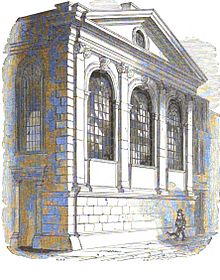St Michael Wood Street
| St. Michael Wood Street | |
|---|---|
 |
|
| Country | United Kingdom |
| Denomination | Church of England |
| Architecture | |
| Architect(s) | Christopher Wren |
| Style | Baroque |
Described by Stow (1598) as a “proper thing”, St Michael’s Wood Street in Cripplegate Ward was the hurried burial site for the head of King James IV of Scotland (Huelin, 1996). First mentioned in 1225 (Harben,1919) the church was destroyed in the Great Fire of London (Reynolds, 1922) and rebuilt after some pressure (Hallows, 1974) by Sir Christopher Wren in 1673 (Whinney,1971). The organ was built by Thomas Elliot in 1800 (Pearce, 1909). In 1854 the declining residential population led to proposals to reduce the number of churches within the “Square Mile” (Times, 1854)- a decision the church's vicar had himself proposed (Hume,1853). The church was eventually demolished under the auspices of the Union of Benefices Act (Hibbert) in 1897 (Cobb) and many bodies were disinterred from the churchyard and reburied at Brookwood Cemetery (Clarke). It was then united with St Alban Wood Street (Norman,1902) and after the destruction of that church in World War II, St Vedast Foster Lane (Betjeman, 1972).
The church was on the west side of Wood Street, initially with a frontage on Huggin Lane but later on Wood Street itself.
The site has undergone several redevelopments and, as of 2013, is occupied by a pub called The Red Herring.
Coordinates: 51°30′56″N 0°5′41.5″W / 51.51556°N 0.094861°W
...
Wikipedia
